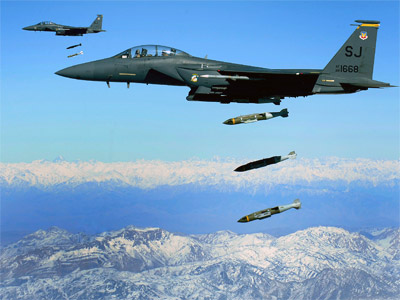The F-15E Strike Eagle Can Kill Almost Anything on Land
The success of the F-15 airframe, and the changing threat environment, led to the production of the ground-attack-capable F-15 E-variant – known as the Strike Eagle.
Meet the F-15E Strike Eagle: The F-15 Eagle was initially designed, famously, “without a pound for ground,” meaning the jet was strictly an air superiority fighter without the capacity to attack ground-based targets.
But the success of the F-15 airframe, and the changing threat environment, led to the production of the ground-attack-capable F-15E-variant – known as the Strike Eagle.
F-15E Strike Eagle: A Distinct Bird
While the Strike Eagle was derivative of the original F-15, the two jets have key differences. Visually, the Strike Eagle is distinguishable for its darker grey camouflage, conformal fuel tanks, and two-seat cockpit.
Mostly, however, the differences between the two jets relate to function. The original F-15s are air superiority fighters. The F-15E Strike Eagle is a multirole strike fighter built for deep penetration yet still capable of defending itself in air-to-air combat.
Essentially, the F-15E is just a much more well-rounded airframe.
And while the F-15E was designed during the 1980s, before the dissolution of the Soviet Union, the Strike Eagle’s utilitarian nature seems prescient – as post-Cold War designs have trended towards versatility and away from specification.
To enable a multirole function, the Strike Eagle carries a back-seat Combat Systems Officer, or CSO (pronounced “sizzo”). The CSO (think Goose in Top Gun) oversees the Strike Eagle’s air-to-ground avionics, including radar, thermographic cameras, and electronic warfare components.
Generally, the CSO is responsible for monitoring threats, selecting targets, and navigating – freeing up the pilot to concentrate on flying the jet. Yet, should the need arise, the Strike Eagle does have a stick and rudder in the backseat, allowing the CSO to pilot the aircraft should the need arise.
The Strike Eagle relies on a tactical electronic warfare system (TEWS), which integrates a variety of countermeasure technology, including radar warning receivers, radar jammer, and chaff/flare dispensers.
The TEWS is dependent upon the ALQ-131, an externally mounted pod that can be carried along the Strike Eagle’s centerline pylon.

To extend the Strike Eagle’s range, thereby facilitating long-range penetration missions, the jet is outfitted with two conformal fuel tanks (CFTs). The CFTs fit snugly against the fuselage, which reduces drag relative to an underwing or under-fuselage external fuel tank.
Each CFT carries 750 gallons of fuel, for a 1,500-gallon boost. Yet, unlike traditional external fuel tanks, the CFTs cannot be jettisoned.
One of the F-15Es most convenient features is the AN/AAQ-13 navigation pod, which has a terrain-following radar.
Using the AN/AAQ-13, the Strike Eagle is able to fly at very low altitudes, following cues that are displaying on the pilot’s heads-up display (HUD). The AN/AAQ-13 can even be activated in autopilot, allowing for hands-off low-terrain following.
Packing a Punch
No aircraft in the US Air Force inventory carries more air-to-ground weapons than the F-15E Strike Eagle. The jet can carry everything from the GBU-39 Small Diameter Bomb to the GBU-28 Bunker Buster to the CBU-107 Passive Attack Weapon.

The Strike Eagle can even be outfitted with the B61 or B83 – thermonuclear gravity bombs; the B61 is a “tactical nuke” with a low to medium yield whereas the B63 has a 1.2 megaton yield, making it the most powerful nuclear weapon in the US arsenal. Fortunately, the F-15E has never been called upon to deploy a nuclear weapon.
In addition to a dazzling array of air-to-ground weapons, the F-15E is also equipped to carry air-to-air missiles like the AIM-7 Sparrow, AIM-9 Sidewinder, and air-to-surface missiles like the AGM-65 Maverick and AGM-84 Harpoon.
The Strike Eagle also carries a 20mm (0.787 in) M61A1 Vulcan 6-barreled Gatling cannon with 500 rounds of ammunition (either M-56 or PGU-28).
Decades of Service
The Strike Eagle was first delivered to the Air Force in 1988 – and was ready for deployment in time for 1991’s Desert Storm.
At the onset of Desert Storm, January 17th, 1991, 24 F-15Es were launched to attack five fixed SCUD installations. F-15Es were also deployed on “hunter” missions in which the jet was used to scout out mobile SCUD launchers. The F-15E would continue to be called upon, throughout the conflict, to engage heavily defended Iraqi targets.
In helping to push Saddam Hussein’s forces out of Kuwait, the Strike Eagle demonstrated its viability in conflict. Accordingly, the platform was called upon repeatedly, as the US became embroiled in conflicts throughout the MENA region that called for the air-to-ground capabilities that the Strike Eagle was renowned for.
Despite being introduced over three decades ago, the US Air Force still operates over 200 F-15Es. The jet has also been successful on the import market, finding homes in US-allied air forces around the globe, including Israel, South Korea, Qatar, Saudi Arabia, and Singapore.
With an F-15E derivative, the F-15EX currently in production, expect some variety of the F-15E to be in service for the foreseeable future.
Harrison Kass is a defense writer and expert with over 1,000 op-eds and analysis pieces published. An attorney, pilot, guitarist, and minor pro hockey player, Harrison joined the US Air Force as a Pilot Trainee but was medically discharged. Harrison holds a BA from Lake Forest College, a JD from the University of Oregon, and an MA from New York University. Harrison listens to Dokken.
All images are Creative Commons.


